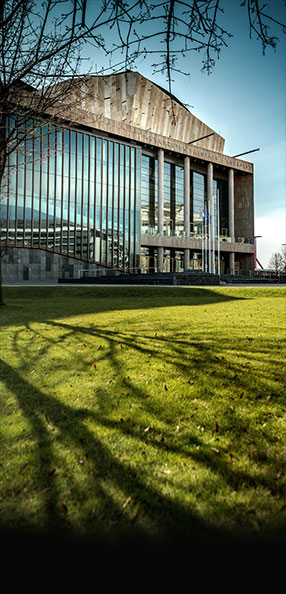On the Danube bank, next to the National Theatre, Palace of Arts advertises the diversity of art since 2005. It gives home to a museum, a festival theatre, one of the largest concert organs in the world, and a concert hall built with special architecture.
Our mini-series of buildings in buildings continues with Palace of Arts. A building not only remarkable because of its cultural value, but also because of the way it was built. Similarly to Budapest Music Center, it offers more than just a concert venue, but its uniqueness lies in the structure of the architecture of Béla Bartók National Concert Hall, which is acoustically a building in a building.

photo: https://www.mupa.hu/en
When Palace of Arts opened in 2005, as a conglomeration of cultural venues, the building had no precedent in the 20th century Hungarian architecture and had no peers in the whole of Central Europe. It is a part of the new Millennium City Centre complex along the UNESCO World Heritage-listed Danube waterfront. Equipped with 21th century technological infrastructure, it’s capable to host performances of any genre and almost any scale.
Three institutions are housed in the building: Béla Bartók National Concert Hall, Ludwig Museum and the Festival Theatre. Individually, all three parts are internationally considered as high quality cultural venues, but the fact that they are all under the same roof makes them even more special. There’s a restaurant, a coffee, a bookshop and a CD store in the building as well, and with its huge windows, it offers an amazing view to the park between Palace of Arts and the National Theatre, as well as to the Danube.
The Ludwig Museum occupies the wing of the building closest to the Danube and is Hungary's only museum dedicated exclusively to the collection and display of contemporary art. Three floors of Hungarian and international fine art, over a total space of 3.300 m2. From photo exhibitions to interactive artworks, the museum is a meeting place for people of all ages interested in and open to the arts.

photo: https://www.mupa.hu/en
The Festival Theatre is situated in the eastern third of the building. It is equipped with the latest sound technology, making it a fantastic venue for theatrical, dance, chamber music, jazz, world and pop music performances. With the theatre’s own video studio, live recording and streaming is possible, and the adjustable stage gives great opportunities for diverse performances.
The architecturally most interesting part (at least for me) of the building is the Béla Bartók National Concert Hall, that is located at the heart of the building.

photo: http://fugaradio.blog.hu/page/13
Palace of Arts is easily approachable, has a huge parking lot, is right next to tram lines 1, 2 and 24, several buses stop by Millenium City Center, and H7 suburban railway stops there too. Good news for those who wish to visit, but challenge for someone who wants to design a concert hall with first class acoustics. Palace of Arts became famous for the world class acoustics of Béla Bartók National Concert Hall’s – thanks to Russel Johnson, a top specialist of his filed, who conducted well over fifty years of research in acoustics and participated in the construction of several top opera houses and concert halls. With close cooperation with the architect, the contractor and leading Hungarian musicians, they managed to build a concert hall not only Tommy Emmanuel likes, but everyone who gets to play here.
To reduce environmental noises and vibrations resulting from municipal traffic, the hall was built almost completely separated from the main walls using spaces in between walls as sound absorbers. Technically, the concert hall is a separate room. Designed with the feel of a Gothic cathedral, the interior design is undetectably subordinate to the acoustics as well. Depending on the type of performance, the depth of the podium can be varied, and the lowered area can function as an orchestra pit if required. The 40-ton canopy suspended overhead, 58 movable resonance chambers each weighing 4 and 8 tonnes, and unusual wall and floor coverings all allow the aural experience to be fine-tuned to the performance. The reliefs of György Jovánovics not only decorate the auditorium, but they also contribute to its outstanding sound quality.
The space is magnificent, and with the pipe organ (with its 92 registers and 5 manuals) - that was inaugurated in spring 2006 – in the center, you get into a solemn mood as you take your seat. No matter what you come to see – from video projections to classical music, jazz/pop/rock concerts, to full orchestra music – you’ll never forget the space you saw and heard it in.
To see Interactive fullscreen 360 degrees panoramas of the concert hall, click here.
Visit the web-site of Palace of Arts for information about upcoming concerts.
Check out Ludwig Museum’s homepage for exhibitions.



















